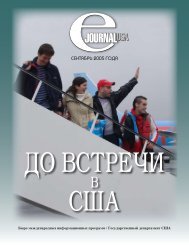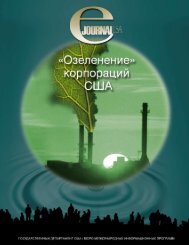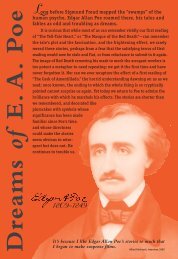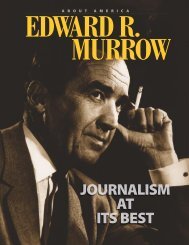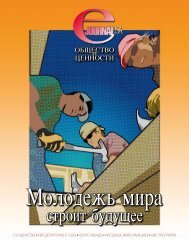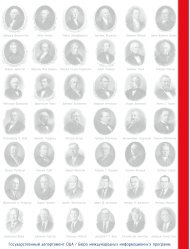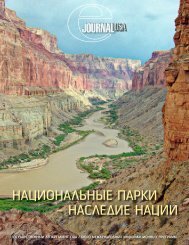AMERICAN
Outline of American Literature
Outline of American Literature
- No tags were found...
Create successful ePaper yourself
Turn your PDF publications into a flip-book with our unique Google optimized e-Paper software.
was born and spent her life in Amherst,<br />
Massachusetts, a small Calvinist village. She<br />
never married, and she led an unconventional<br />
life that was outwardly uneventful but was<br />
full of inner intensity. She loved nature and<br />
found deep inspiration in the birds, animals,<br />
plants, and changing seasons of the New England<br />
countryside.<br />
Dickinson spent the latter part of her life as<br />
a recluse, due to an extremely sensitive<br />
psyche and possibly to make time for writing<br />
(for stretches of time she wrote about one<br />
poem a day). Her day also included homemaking<br />
for her attorney father, a prominent figure in<br />
Amherst who became a member of Congress.<br />
Dickinson was not widely read, but knew the<br />
Bible, the works of William Shakespeare, and<br />
works of classical mythology in great depth.<br />
These were her true teachers, for Dickinson was<br />
certainly the most solitary literary figure of her<br />
time. That this shy, withdrawn village woman,<br />
almost unpublished and unknown, created some<br />
of the greatest American poetry of the 19th century<br />
has fascinated the public since the 1950s,<br />
when her poetry was rediscovered.<br />
Dickinson’s terse, frequently imagistic style<br />
is even more modern and innovative than<br />
Whitman’s. She never uses two words when one<br />
will do, and combines concrete things with<br />
abstract ideas in an almost proverbial, compressed<br />
style. Her best poems have no fat; many<br />
mock current sentimentality, and some are even<br />
heretical. She sometimes shows a terrifying<br />
existential awareness. Like Poe, she explores<br />
the dark and hidden part of the mind, dramatizing<br />
death and the grave. Yet she also celebrated simple<br />
objects — a flower, a bee. Her poetry exhibits<br />
great intelligence and often evokes the<br />
agonizing paradox of the limits of the human consciousness<br />
trapped in time. She had an excellent<br />
sense of humor, and her range of subjects and<br />
treatment is amazingly wide. Her poems are generally<br />
known by the numbers assigned them in<br />
Thomas H. Johnson’s standard edition of 1955.<br />
They bristle with odd capitalizations and dashes.<br />
A nonconformist, like Thoreau she often reversed<br />
meanings of words and phrases and used<br />
paradox to great effect. From 435:<br />
Much Madness is divinest sense —<br />
To a discerning Eye —<br />
Much Sense — the starkest Madness —<br />
‘Tis the Majority<br />
In this, as All, prevail —<br />
Assent — and you are sane —<br />
Demur — you’re straightway dangerous<br />
And handled with a chain —<br />
Her wit shines in the following poem (288),<br />
which ridicules ambition and public life:<br />
I’m Nobody! Who are you?<br />
Are you — Nobody — Too?<br />
Then there’s a pair of us?<br />
Don’t tell! they’d advertise — you<br />
know!<br />
How dreary — to be — Somebody!<br />
How public — like a Frog —<br />
To tell one’s name — the livelong<br />
June —<br />
To an admiring Bog!<br />
Dickinson’s 1,775 poems continue to intrigue<br />
critics, who often disagree about them. Some<br />
stress her mystical side, some her sensitivity to<br />
nature; many note her odd, exotic appeal. One<br />
modern critic, R.P. Blackmur, comments that<br />
Dickinson’s poetry sometimes feels as if “a cat<br />
came at us speaking English.” Her clean, clear,<br />
chiseled poems are some of the most fascinating<br />
and challenging in American literature. ■<br />
35




